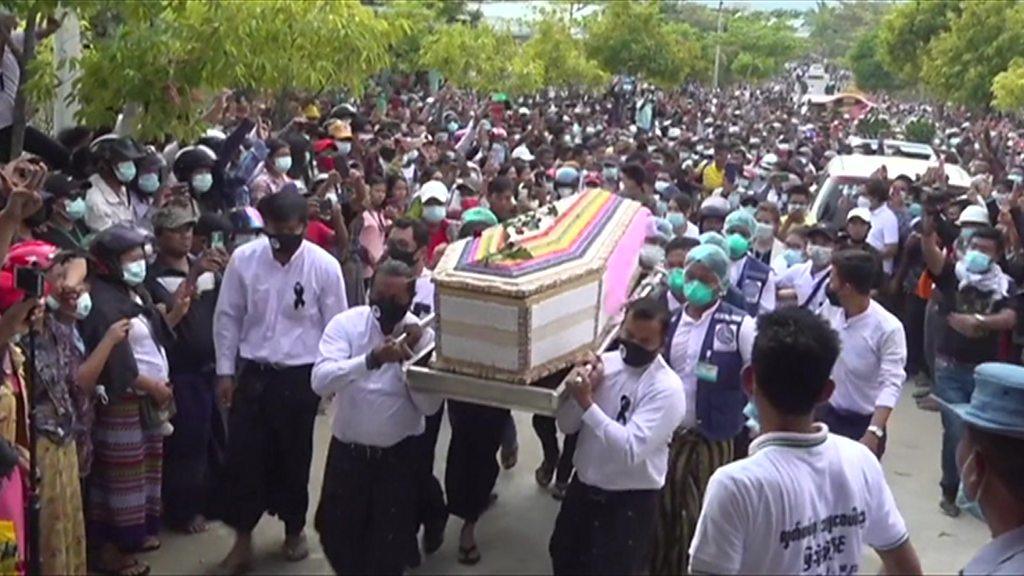Myanmar coup: Huge crowds mourn woman killed in protests
- Published
Mya Thwe Thwe Khaing was shot in the head just before her 20th birthday by security forces
Huge crowds in Myanmar's capital Nay Pyi Taw have attended the funeral of a young woman killed in protests against a military coup.
Mya Thwe Thwe Khaing was shot in the head just before her 20th birthday, the first of at least three people to die in the protests.
On Sunday, thousands lined the streets to honour her, some making the three-fingered salutes used by demonstrators.
The military overthrew the elected government earlier this month.
Promises to hold early elections have failed to satisfy demonstrators, who are also seeking the release of the elected leader Aung San Suu Kyi and other members of her National League for Democracy (NLD) party.
The military alleges the NLD's landslide election win last year was fraudulent but has not provided proof.
Mya Thwe Thwe Khaing, a supermarket worker, was injured when police tried to disperse protesters earlier this month. She was kept on life support for 10 days but died on Friday.
She has become a focal point for demonstrators, with her image often displayed by people resisting the coup.
Her coffin was driven through the streets in a black and gold hearse, accompanied by hundreds of motorbikes.
Protesters took to the streets across the country again on Sunday, despite the previous day seeing the worst violence yet in weeks of protests.

Mya Thwe Thwe Khaing's body was driven through the streets of the capital
Two protesters were shot dead when police used live ammunition to disperse crowds.
The deaths brought widespread condemnation, with UN Secretary General Antonio Guterres, external saying: "The use of lethal force, intimidation & harassment against peaceful demonstrators is unacceptable."
Also on Sunday, the wife of prominent actor Lu Min said he had been arrested after posting a video denouncing the military leadership.

Escalating daily protests

The two-week-old civil disobedience movement in Myanmar now has its martyrs - represented in posters, paintings and cartoons at rallies which have continued to take place across the country.
Their deaths will inflame public anger against the military government, but remind people too of the cost of resisting it.
The plan now is to escalate the daily protests into a nationwide general strike, starting next week.
This must damage an economy which is already suffering from the Covid pandemic - but its effect on the generals who seized power is harder to predict.

Facebook blocks military-run news site
In the early hours of Monday, Myanmar entered its second week of nightly internet shutdowns, monitoring group NetBlocks reported.
The junta has been regularly blocking the web to try to stifle mass protests.
Earlier, social media giant Facebook deleted a news site run by the military.
"In line with our global policies, we've removed the Tatmadaw True News Information Team Page from Facebook for repeated violations of our Community Standards prohibiting incitement of violence and coordinating harm," the company said.
From blindfolded protests to dressing like Aung San Suu Kyi, why creatives are concerning Myanmar's army
The site is the main one run by the military, used to issue warnings to protesters and push its allegations about the election results.
Facebook is the primary source of information and news in Myanmar. An estimated 22 million of the 54 million people in Myanmar use Facebook.
The military's leader Min Aung Hlaing and other top army chiefs are already banned from Facebook over allegations of human rights abuses against Rohingya Muslims.

Myanmar in profile
Myanmar, also known as Burma, became independent from Britain in 1948. For much of its modern history it has been under military rule
Restrictions began loosening from 2010 onwards, leading to free elections in 2015 and the installation of a government led by veteran opposition leader Aung San Suu Kyi the following year
In 2017, militants from the Rohingya ethnic group attacked police posts, and Myanmar's army and local Buddhist mobs responded with a deadly crackdown, reportedly killing thousands of Rohingya. More than half a million Rohingya fled across the border into Bangladesh, and the UN later called it a "textbook example of ethnic cleansing"


Related topics
- Published21 February 2021

- Published4 February 2021

- Published1 February 2021
